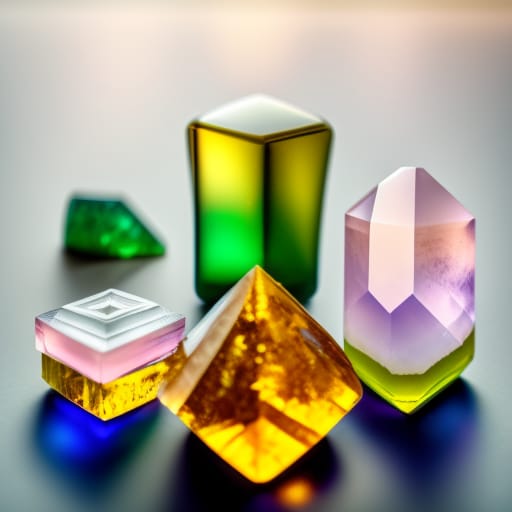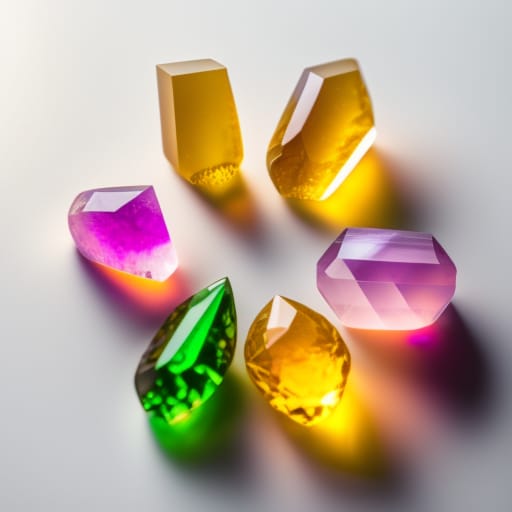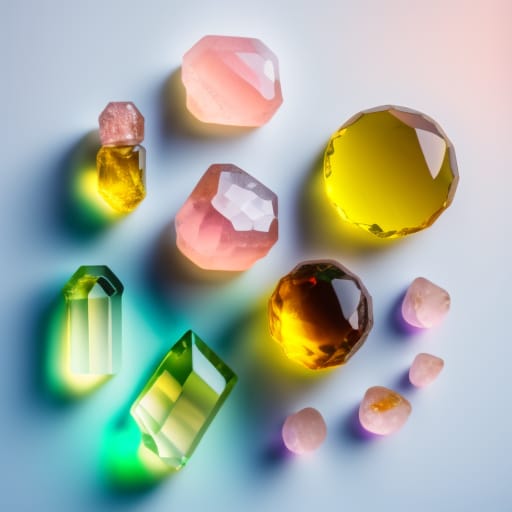Have you ever wondered what those sparkling crystals are made of and how they form? Growing your own crystals is an enriching, hands-on hobby that allows you to produce beautiful formations with many uses and benefits. In this beginner’s guide, we’ll explore the magical world of crystal growing and identify the best crystals you can easily grow at home.

An Introduction to Crystals
Crystals are solid minerals made up of atoms, molecules, or ions arranged in an orderly, repeating 3D pattern. The word “crystal” comes from the Greek word “krystallos” meaning clear ice.
While crystals can form naturally underground through geological processes over thousands of years, synthetic crystal growing lets you produce perfect specimens in a matter of days or weeks.
The earliest recorded crystal growth experiment was detailed by Sir Isaac Newton in 1664. Today crystal growing is a popular educational and fun DIY project. Crystals are used in various industries from semiconductors to jewelry. Many also believe crystals have healing or spiritual properties.
Types of Crystals
There are several ways to classify crystals:
Natural vs Synthetic
- Natural crystals form without human intervention through natural geological processes. Natural crystals can take thousands of years to form underground and have irregular shapes.
- Synthetic crystals are manufactured under controlled lab conditions to create perfect crystalline structures. Synthetic crystals grow much quicker than natural ones.
Organic vs Inorganic
- Organic crystals come from substances with carbon such as proteins or amino acids. Organic crystals include crystals formed from urea or glycine.
- Inorganic crystals do not contain carbon but are made up of mineral salts. Common examples are crystals of sodium chloride or copper sulfate.
How Do Crystals Grow?
Crystal growth depends on several key factors that must be carefully controlled:
Temperature
The rate of crystal growth increases with temperature as atoms and molecules move faster in warmer solutions. However, impurities also increase at higher temperatures which can distort the crystal lattice.
Concentration/Supersaturation
A supersaturated solution contains more dissolved solute than normal at a given temperature. Supersaturation provides the driving force for molecules to come out of solution and crystallize.
Solvent
The solvent provides a medium for the solute molecules or ions to move and rearrange into a crystal lattice. Water is the most common solvent but others like acetone can also be used.
Seed Crystal
A tiny piece of the crystal material acts as a template for further growth in an ordered pattern. The seed crystal’s molecular structure is replicated as more molecules attach.
Pressure
Increased pressure keeps solute molecules closer together so crystallization occurs more readily. Pressure vessels are used for commercial crystal growing.
The Best and Most Popular Crystals to Grow at Home
Now that we understand how crystals form, let’s look at some of the best and most popular crystals you can easily grow at home:
Clear Quartz Crystals
Clear quartz is one of the most common and readily available crystal types. It has a vitreous luster and hexagonal prismatic shape. Silicon dioxide is the chemical formula.
How to grow: Mix 1 part sodium silicate solution to 3 parts distilled water. Pour into a jar with a seed crystal and screw on the lid. Place it in a warm spot at 75-85°F. Crystals form within 1-2 weeks.
Uses: Clear quartz crystals are used for their piezoelectric properties. They are also popular for spiritual healing and meditation.
Copper Sulfate Crystals
Copper sulfate forms beautiful blue triclinic crystals. The chemical formula is CuSO4. Copper sulfate solutions have a bright blue color.
How to grow: Mix 20 g copper sulfate powder in 100 ml boiling water until fully dissolved. Pour into a glass jar with a copper wire or crystal fragment. Cool slowly to room temperature.
Uses: Copper sulfate crystals are sold as fungicides and used to make other copper compounds. The striking blue color is used in decorative crafts.
Epsom Salt Crystals
Epsom salt is hydrated magnesium sulfate with the chemical formula MgSO4·7H2O. The crystals are formed when magnesium sulfate powder is dissolved in water.
How to grow: Stir 2-3 tablespoons of Epsom salts in 1 cup hot water until fully dissolved. Pour the solution into a glass dish, jar, or bowl and let it stand undisturbed overnight. Large crystals will form as the water evaporates.
Uses: Epsom salt crystals are used to soothe aches and pains. They have many household and gardening uses too.
Sugar Crystals
Table sugar has the chemical name sucrose and formula C12H22O11. Dissolving and recrystallizing sucrose creates large sparkling sugar crystals.
How to grow: Heat 1 cup water and stir in as much sugar as possible until saturated. Allow to cool slightly and pour into jars with sticks or strings as seed crystals. Cover with perforated lids. Crystals grow in 5-7 days.
Uses: Sugar crystals can decorate cakes and candy. They are also used as abrasives for exfoliating skin. Kids love growing sugar crystals for science experiments.
Borax Snowflake Crystals
Borax is sodium tetraborate decahydrate with the formula Na2B4O7·10H2O. It crystallizes into beautiful whimsical shapes that resemble snowflakes.
How to grow: Mix 1 cup hot water with 1-2 tablespoons of borax powder until fully dissolved. Add 2-3 drops of food coloring if desired. Pour into containers and poke sticks halfway down. Let it cool for crystals to appear on the sticks.
Uses: Borax crystals make amazing ornaments. Borax is used as a cleaning booster and fungicide. The crystals also have applications in chemistry experiments.

The Healing Properties of Crystals
Many believe that crystals emit beneficial energy fields that can heal the mind, body, and spirit. While scientific evidence is limited, thousands of people use crystals in spiritual practices. Some commonly used healing crystals are:
Quartz
- Clear quartz – amplifies energy
- Rose quartz – promotes love
- Smoky quartz – relieves stress
Aventurine
- Green aventurine – prosperity and luck
Agate
- Moss agate – self-confidence and harmony
Other Healing Crystals
- Chrysocolla – communication
- Malachite – emotional balance
- Tiger’s eye – focus and insight
- Selenite – clarity and truth
Healing crystals are usually kept on the body as jewelry or placed around the home. Many also meditate with crystals.
The Spiritual Meaning Behind Crystals
Beyond physical healing, crystals are traditionally used to open up spiritual awareness and bring positive energy into someone’s life. Different crystals have various properties based on their structure and origins. Some examples:
- Amethyst – A common protective crystal that blocks negative energy and promotes spiritual growth. Also brings wisdom, calm, and focus.
- Citrine – The “success stone” that encourages prosperity. Its golden color represents vitality and abundance.
- Obsidian – Provides spiritual grounding as a black protective stone. Helps clear subconscious blocks.
- Clear quartz – A master healer and amplifier crystal. Enhances clarity and intuition.
- Rose quartz – Known as the love crystal. Opens up the heart chakra to attract friendship, affection, and closeness.
Fun Crystal Growing Projects
Growing your own crystals is an enlightening way to understand these mesmerizing mineral forms. There are many creative crystal-based science experiments and projects you can take up as an engaging hobby:
Grow an Amethyst Geode
Geodes are hollow rocks filled with crystal formations. This project grows amethyst crystals on a shell to mimic a geode:
Materials needed: amethyst crystal, eggshell, borax, glue, jar/bowl
- Crush the amethyst into small shards
- Coat the inside of an eggshell with glue and borax mixture
- Place the amethyst shards inside and let sit for 48 hours
- A magical mini amethyst geode is ready!
Grow Alum Crystals on Branches
This experiment forms octahedral alum crystals on real wood:
Materials needed: alum powder, baking soda, branches
- Boil branches in baking soda solution for 1 hour
- Cool the branches and place in a strong alum solution
- White alum crystals will cover the branch
- Let the crystal-covered branch dry
Grow Your Own Crystal Gemstone Tree
This magical crystal tree makes a great decoration:
Materials needed: amethyst, rose quartz or citrine pieces, playdough, jar
- Make “roots” out of playdough and place amethyst chunks on top
- Put the ends of the roots in water and cover with a jar
- Crystals will grow upwards on the roots over 2-3 weeks
- Your crystal tree is ready to showcase!
Using Crystals for Plants
The beneficial energy from crystals can also promote plant and garden vitality when properly used:
- Bury clear quartz shards near plants to amplify their overall health.
- Place citrine crystals in planters to encourage strong root systems and plant growth.
- Clear quartz water energizers purify water for more vibrant plants.
- Mixing crushed moonstones, rose quartz, or amethyst into potting soil nourishes plants with positive crystal energy.
- Pointing selenite wands toward seedlings prevents disease and boosts germination.
- Massaging sprouts with rose quartz pieces leads to quicker, healthier plant growth.
- Leave smoky celestial quartz in the garden to protect plants from pests and rodents.
Starting a Crystal Collection
Once you gain experience growing crystals at home, you may be tempted to begin your own crystal collection featuring beautiful specimens sourced from around the world. Some common crystal collector items include:
- Polished gemstones like emeralds, sapphire, and rubies
- Natural raw crystal cluster formations
- Rare single-point crystals and prisms
- Fossils containing aged crystals
- Fluorescent mineral specimens like calcite
- Meteorites with crystalline extraterrestrial minerals
Key tips for starting a crystal collection:
- Start small and only purchase high-quality specimens from trusted dealers.
- Proper labeling and documentation preserve value.
- Store collection in secure glass cabinets away from direct light.
- Don’t clean specimens as they may damage lustre and patina.
- Joining a mineral club opens up access to shows, events, and resources.

Final Thoughts
The enchanting world of crystal growing offers a meaningful hands-on hobby that is both scientifically educational and spiritually enlightening. All it takes are some simple materials and patience to grow your own flawless crystals at home.
Start with easy crystal types like clear quartz, copper sulfate, and epsom salt to get the basics down. Work your way up to more advanced formations for tailored crystal creations. Consider using your crystals for spiritual practices, plant care, or starting a collection.
Growing and appreciating the symmetry, colors, and energy of crystals provides a sense of wonder and closeness with nature. It’s both meditative and nourishing for the soul.
There’s something undeniably magical about crystallization. Hopefully, this beginner’s guide has revealed the incredible beauty and possibilities that crystals provide. Their ordered geometry is a reminder of the fundamental patterns and harmony of the universe.
Frequently Asked Questions
What are the fastest-growing crystals?
Some of the quickest crystals to grow are epsom salt, copper sulfate, and sugar crystals. These can form large crystals overnight or within 1-2 weeks under the right conditions. Other fast-growing crystals are alum and borax.
What are the easiest crystals to grow at home?
The most beginner-friendly crystals to grow are clear quartz, epsom salt, copper sulfate, and borax snowflakes. These only require simple materials like water, string, and mineral salts. With basic steps, even kids can grow these crystals quickly.
What minerals are best for crystal healing?
Popular crystals with healing properties include rose quartz for unconditional love, amethyst for spiritual protection, citrine for prosperity, and green aventurine for luck and opportunity. Clear quartz is a master healer that amplifies energies.
Which crystals are lucky?
Known as lucky stones, citrine, and green aventurine attract success and abundance. Tiger’s eye brings focus and malachite improves emotional health for more balanced energy. Rose quartz strengthens relationships and social bonds.
Can you grow crystals in your garden?
Yes, certain crystals like clear quartz and shungite can be buried in gardens to provide purification and protection. Citrine and rose quartz in plant beds encourage healthy root growth. Always research first to ensure the crystals are garden-safe.